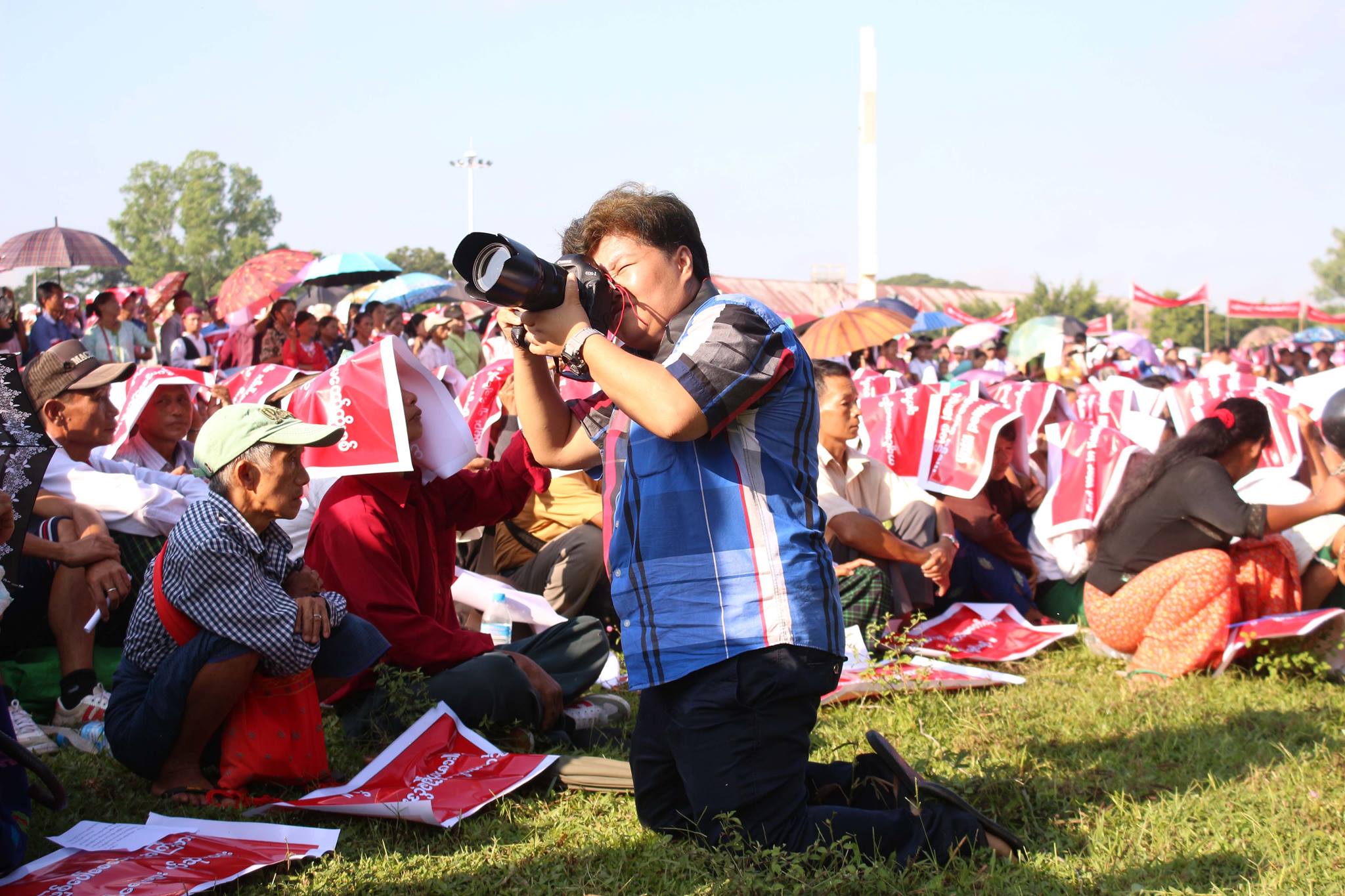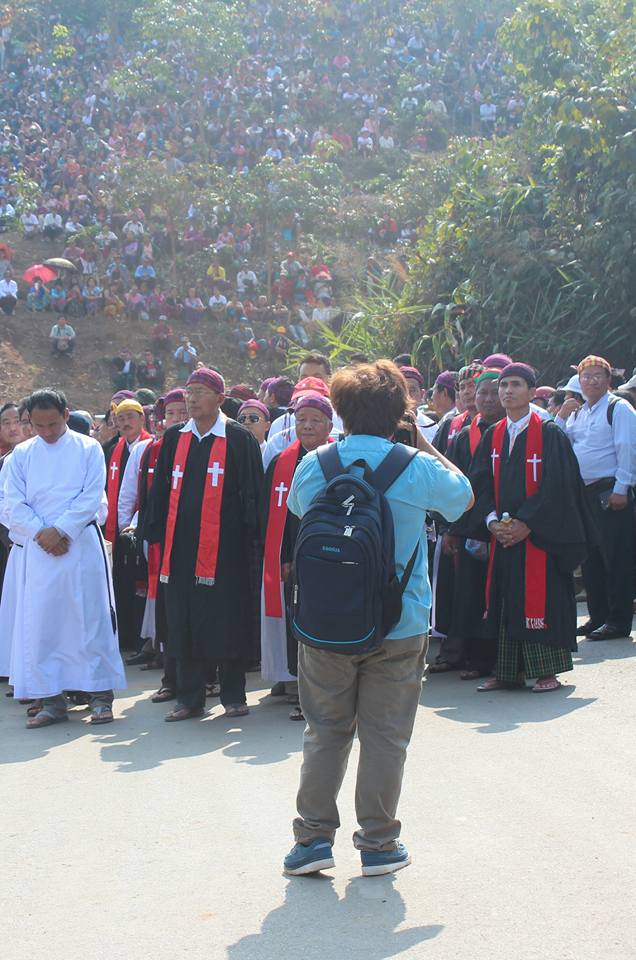MEET THE ONLY WOMAN EDITOR IN-CHIEF IN THE COUNTRY, TRAINING STAFF FROM SCRATCH, WITH NO INTERNET. SHE PUTS OUT ONE OF THE BEST INDEPENDENT PAPERS IN MYANMAR.
I am in the far north of Myanmar, walking through the main public park in the capital of Kachin state with Seng Mai, the only woman editor in chief in a country whose newly-expanded press freedoms have created an explosion of newspapers with a huge range of quality. We are in the park because it was here that Seng Mai wrote a groundbreaking story, interviewing the dozens of drug addicts who hung out on the park grounds, shooting up down by the river and leaving their dirty needles scattered about.

“At the time I wrote the story, in 2013, there was very little that proved the assertion that drug use in Kachin state is very high,” Seng Mai said. “I hung out and made friends with the drug dealers and the users and uncovered their stories. It turns out they felt protected using in the park, because it is a sacred cultural place for the Kachin people and the police did not investigate here. After the story broke, the police came and cleaned up the park.”
Over the next two days, I would come to learn that Seng Mai is fearless. As a cub reporter, working before the press freedoms were established in Myanmar in 2011, she reported about environmental damage and human rights abuses perpetrated by Chinese companies in the sugar cane fields in northern Kachin. She went deep into stories about heroin use and trafficking, driven by her concern that the government is looking the other way while this enormous social issue decimates the population. These are tricky political issues and there are many powerful interests involved. When I ask her if she is ever worried for her safety, she simply replies, “The role of media is to inform people. They need to know what is going on. They need to be educated about the drug use and what is happening with our resOther major stories Seng Mai and her staff at the Myitkyina News Journal track on a regular basis include human rights abuses at the jade mines and in other resource industries, readiness for the elections slated for November of this year, corruption in the army and the local government and the increasingly desperate plight of the state’s growing population displaced by the on-going conflict between the Burmese army and the Kachin Independent Army (KIA). This number is currently 120,000 and climbing.
The Myitkyina Journal offers a shining example of good, independent journalism in Myanmar, a country whose newly open press policy has generated an explosion of media, yet has few trained journalists. The results have been varied. While there are some solid news outlets in Yangon, many others are controlled by political factions and continue to produce propaganda or opinion-driven content that passes for news. In the outlying states, where most of Myanmar’s ethnic groups live, unbiased, independent journalism is almost nonexistent. The Myitkyina Journal is one of a handful of regional newspapers struggling to tell local stories for local people based on well-sourced facts. The Journal’s founders, Seng Mai and the publisher, Brang Mai, made the decision to publish in Burmese, not the local Kachin language, in order the reach the widest audience in the region, 50% of which is made up of the Kachin ethnic population who are primarily Christians.
REGIONAL NEWS IS CRITICALLY IMPORTANT IN MYANMAR. HERE’S WHY.
Myanmar is in the middle of two deeply important and connected transitions. The first is the transition to democracy, which began with the reform process in 2011. Elections have been announced for November 8th of this year and the world will be watching to ensure that they are credible, inclusive and transparent. The second transition is the fragile peace accord signed this past March between the Burmese government and 14 ethnic groups. This agreement seeks to end one of the world’s longest running civil wars.

As Priscilla Clapp, Senior Adviser at the US Institute of Peace and the Asia Society, recently commented, “The conflict with the Kachin reignited as soon as this new government came into power. Kachin is where most of the resource wealth of the country resides, and they’re fighting over territory and resources. The army wants to control that, and the Kachin want to control it, and they haven’t been able to reach any kind of agreement.” Currently, there is no ceasefire agreement between the Burmese army and the Kachin Independent Army (KIA).
In this mix, the Myitkyina Journal has a particularly critical role. In many areas of the state, such as the internally displaced persons’ (IDP) camps and the jade mines where heroin use is rampant, the government tightly restricts access to outsiders. Local journalists are often the only witnesses to the truth on the ground.
“Our journal is often the only place where certain stories are accurately covered. We do a lot of reporting on the peace process and the IDP populations. For many international organizations, we are becoming a primary source of information,” Seng Mai said.
The drug problem and the resource curse travel together in Kachin. “We have had trafficking in illegal resources for many years in Kachin and this works hand in hand with the drug problem. Most of the companies that control the jade and gold mining are Chinese and they cooperate with the government. Most of the people that work there are Kachin. Heroin is widely available at the jade and gold mines. The logging industry is even worse. There the workers were forced to take drugs. They become ad
dicts. We lose our resources and become slaves in our own state,” Seng Mai said.
REGAINING THE SCARCEST RESOURCE : TRUST
The capacity for an ethnic media outlet to produce independent news remains a rarity in Myanmar. As soon as the press restrictions were lifted, much of the ethnic media was simply propaganda for armed ethnic groups. It has taken time for the idea of an independent, regional paper to take hold.
The Myitkyina Journal has made real progress in gaining the trust of a local population weary of decades of war and propaganda. In one year, circulation has risen from 6,000 papers twice a month to 10,000 every ten days. The paper has local advertising. Combined with some donor support, the paper is breaking even and being distributed throughout Kachin state and into other parts of upper Myanmar. A web site and even a potential radio station are part of the next stage of the vision.
“For the first year, people didn’t know what to make of us. Are we a KIA journal? A journal of the Burmese ministry? Now they understand that we are independent, which is a new concept here. They understand that we are the voice of the people and we don’t take sides. The people trust us.”
It has not been easy to get to this point. Visiting their modest offices in a quiet residential neighborhood in Myitkyina makes it easy to see why. Resources are minimal and capacity is a significant hurdle to growth. Seng Mai and her publisher and business partner, Brang Mai, have had to train all of their staff from the ground up. The local educational system in the region has been eroded to the point where it almost ceases to function, making staffing one of their key challenges.
“Ours is the first journal of its kind in Kachin. We started from zero for everything, from the layout designs, arranging forms, marketing, advertising sales, and training the reporters. We even had to train the typists. We did all the training and at first, we had high turnover, so we kept having to start again with new staff,” said Seng Mai.
Another huge hurdle is the low level of technology. The Myitkyina Journal is produced with no internet connection. The staff does layout on a computer, copies the files to a thumb drive, and mails the drive to Mandalay where plates are produced. These plates are sent back to Myitkyina where the papers are printed, bundled, and readied for distribution. The turnaround time for this process is roughly 10 days and is the primary reason the paper comes out three times per month. In an attempt to keep up with breaking news, the team publishes 10,000 news inserts for every issue on an in-house printer that Seng Mai stays up all night to babysit.
Even with these huge obstacles, Seng Mai and Brang Mai are committed to the success of the Myitkyina Journal. Reporting on significant issues at the heart of Myanmar’s transformation is what drives Seng Mai and the Myitkyina Journal is a long-held dream. Seng Mai said, “After I decided to become a journalist, I came to Internews. On the first day of training, my trainer asked me what my goals were. I told him that I want to establish a regional and a local journal. It has always been my dream. And now I have done it.”
Publisher Brang Mai worked with Internews for eight years in our offices just across the border in Chiang Mai, where the organization was active when Burma was one of the most closed countries in the world. Seng Mai participated in Internews’ year-long journalism program based in Chiang Mai. She said, “I’d like to say thank you to Internews because it taught me to be a good journalist. Internews is always there for me for whatever I need for training and support. Our two computers are from Internews. They helped us get started.”
Internews currently runs a range of training and production programs to support independent media in Myanmar. Its flagship program is the NewsLab training unit which draws working journalists from diverse backgrounds together in professional newsroom conditions.
Credit: Jennifer Cobb/Internews)



